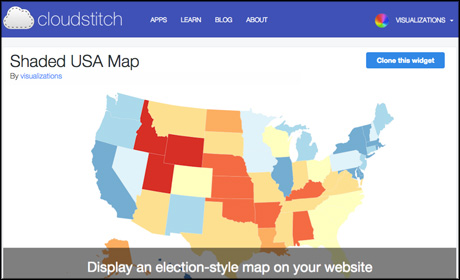
A web app designed to make data-driven storytelling more accessible for journalists with no coding experience has been awarded $35,000 (£22,805) in the latest round of Knight Foundation prototype funding.
Cloudstitch, currently in private beta, aims to offer an open source model for non-programmers to produce interactives which can then be integrated into any website.
Ted Benson, who founded Cloudstitch along with Jake Lau, told Journalism.co.uk he believes the app can do for data what WordPress did for online publishing.The next stage in the way we communicate is involving dataTed Benson, Cloudstitch
"At the end of the day people want to communicate effectively... the next stage in the way we communicate is involving data," explained Benson, who is based in Cambridge, Massachusetts.
"We can build beautiful websites with great typography now, and the next logical step is to put data online and let people interact with that data.
"So we think this is very important for the same reason that WordPress was important. It helps journalists, people with stories, to tell better, more complex and more involved stories in a new way."
The core premise behind its usability is that it runs off Google Docs spreadsheets, which newsrooms from the Guardian to the Wall Street Journal are already using to manage workflows and aggregate data.
As well as the familiarity most people have with Google Docs, this also means Cloudstitch benefits from the collaborative features of the platform, allowing multiple users to work on the same project and view each other's edits.
Benson graduated from MIT's computer science and artificial intelligence laboratory (CSAIL) last summer, and Cloudstitch is based on his PhD dissertation research into how to "re-invent creation on the web".
Part of this, he explained, is to relieve the pressure on newsrooms who may only have a small development team by enabling more collaboration and experimentation from other non-programmers.
"In any creative community there's kind of this pyramid of skills, so you have this small set of experts and a very large base of people who maybe aren't experts but who can fiddle with things and modify things once they've been created.
"We want to allow the small group of experts to create things that people can modify in meaningful ways.

Image provided by Cloudstitch.io
There are of course many other off-the-shelf platforms available for producing data-driven stories – Tableau, Story Maps and Infogr.am to name a few.
What makes Cloudstitch different from these platforms, said Benson, is its "open-ended creation environment".
"What we're aiming to do is provide the plug-in architecture for the whole web, for Wordpress, for Wix, for Squarespace, for your blog, for your custom website."
As a comparison he pointed to D3.js, the JavaScript library sometimes used by The New York Times to create data visualisations.
"If you want to re-use one of these [D3 visualisations], you have to know Javascript," said Benson, "so one way to think about Cloudstitch [is] a way to package those visualisations and power them with a spreadsheet."
Further, because Cloudstitch is almost entirely open source, if the platform was to disappear for any reason journalists could preserve their interactives by downloading the code. "You could run a server yourself, you could run these applications yourself," Benson noted.
Prior to the Knight Foundation award Cloudstitch was funded by a seed grant for an undisclosed sum from Rough Draft Venture, a Boston venture capital firm.
The platform's payment model is still under consideration but Benson expects it to work in a similar way to GitHub.
"We'd like to create a big creative community of people who are publishing things to share for free, and then we expect that we'll charge for private hosting and some businesslike services on top of that," he said.
Benson and Lau are currently in "the initial stages" of collaborating with news outlets, with Benson noting interest from The Boston Globe, The Connecticut Mirror and The Tech, a local newspaper at MIT.
The Knight funding will go toward the "co-production of these interactives with newsrooms", he said, funding the hire of designers and development efforts to see "whether or not this model of creating interactives works for them."
Free daily newsletter
If you like our news and feature articles, you can sign up to receive our free daily (Mon-Fri) email newsletter (mobile friendly).









